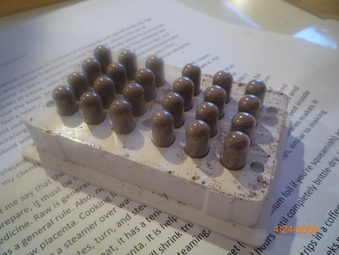
Do It Yourself Encapsulation
Placenta Encapsualtion is not exactly complicated, but if at all possible, we highly recommend hiring a trained professional to perform this service for you. It is important to follow food safety protocols for the mother's safety, and blood borne pathogen protocols for the encapsulators safety, and the safety of those who will be in that space. In addition, a professional will work quickly to get the capsules so mom can begin taking them as soon as possible.
If you are choosing not to hire a professional, you will ideally have a friend or family member who is willing to do it for you shortly after the birth. I believe new moms should be in bed, resting and nursing their new baby during that first week or two after having a baby. It’s best for the capsules to be ready by about day two or three postpartum so a mother can start taking them before the big hormonal shift that occurs around that time happens (when a mom’s milk is increasing in volume and some moms report feeling the baby blues). NOTE: Taking the capsules doesn’t guarantee a mom may not still feel this hormonal shift, or have some emotional times, but it should help ease the transition. It’s normal to feel emotional and maybe even cry for no reason some time around day 3 to 5 postpartum. It is very normal and mom just needs a little extra support and encouragement during this time. If those feelings continue and get worse, then of course Mom or partner should seek out further help.
Traditional Method Instructions
Raw Start Method Instructions
Follow the instructions above, skipping the steaming step. A very sharp knife is necessary to slice easily. Slice as thin as possible. For a true raw preparation you will need a food dehydrator that can be set to approximately 115 degrees, though safe food preparation protocols require us to use 160 degrees when preparing using the raw start method and we recommend the same for those doing it at home on their own. It may take 24 hours or more for a raw placenta to fully dehydrate so make sure not to proceed to the next step until you are 100% it is fully dried out and the pieces snap easily. If a mom is GBS positive she must dehydrate the placenta at 160 degrees for 24+ hours to ensure all bacteria is killed. Doing the Traditional Method offers even more protection.
Watch this video of Anne on the news talking about placenta encapsulation!
Placenta Encapsualtion is not exactly complicated, but if at all possible, we highly recommend hiring a trained professional to perform this service for you. It is important to follow food safety protocols for the mother's safety, and blood borne pathogen protocols for the encapsulators safety, and the safety of those who will be in that space. In addition, a professional will work quickly to get the capsules so mom can begin taking them as soon as possible.
If you are choosing not to hire a professional, you will ideally have a friend or family member who is willing to do it for you shortly after the birth. I believe new moms should be in bed, resting and nursing their new baby during that first week or two after having a baby. It’s best for the capsules to be ready by about day two or three postpartum so a mother can start taking them before the big hormonal shift that occurs around that time happens (when a mom’s milk is increasing in volume and some moms report feeling the baby blues). NOTE: Taking the capsules doesn’t guarantee a mom may not still feel this hormonal shift, or have some emotional times, but it should help ease the transition. It’s normal to feel emotional and maybe even cry for no reason some time around day 3 to 5 postpartum. It is very normal and mom just needs a little extra support and encouragement during this time. If those feelings continue and get worse, then of course Mom or partner should seek out further help.
Traditional Method Instructions
- Remove the cord and wash excess blood from the placenta.
- The membranes may be cooked with the placenta and it is helpful to tuck the placenta inside the membrane when you cook it.
- Place the in a steamer basket over an inch of water with fresh ginger slices, one sliced lemon and a jalapeno pepper. Gently steam for approximately 15-20 minutes (start timing when the water is boiling), turn, and steam for 15-20 minutes more, until no juice comes out when pricked with a fork. (Turn down the heat immediately once it starts steaming so it doesn’t boil over. It makes clean-up much easier. BELIEVE ME.) You can also skip the steamer basket completely and just lay the placenta on the cut lemons with a very small amount of water in the bottom of the pot. This makes clean up much easier.
- After steaming, slice the placenta into very thin strips, similar to making jerky. Slice as thinly as possible. (Tip: Before slicing, let the placenta cool while you immediately wash the pot. Much easier to clean!)
- Place the strips on a cookie sheet (covered with parchment paper) and place in an oven on the lowest possible setting for 10-12 hours, until they are completely dry (they should snap). If you have a food dehydrator for this step, even better. You can line your food dehydrator with parchment paper and dehydrate overnight, 10-12 hours. They must be completely dry before proceeding. Most ovens do not get down to 160 degrees and therefore may burn the placenta more than dehydrate it.
- Break the slices up into smaller pieces and grind them to a fine powder with a coffee grinder, magic bullet or even a mortar and pestle.
- You will want a simple capsule maker to put the powder into the capsules. You can find one at your local natural food co-op or online. We use size "0" capsules.
- Store the capsules in a dry, dark place in a dark colored jar with a tight-fitting cap.
Raw Start Method Instructions
Follow the instructions above, skipping the steaming step. A very sharp knife is necessary to slice easily. Slice as thin as possible. For a true raw preparation you will need a food dehydrator that can be set to approximately 115 degrees, though safe food preparation protocols require us to use 160 degrees when preparing using the raw start method and we recommend the same for those doing it at home on their own. It may take 24 hours or more for a raw placenta to fully dehydrate so make sure not to proceed to the next step until you are 100% it is fully dried out and the pieces snap easily. If a mom is GBS positive she must dehydrate the placenta at 160 degrees for 24+ hours to ensure all bacteria is killed. Doing the Traditional Method offers even more protection.
Watch this video of Anne on the news talking about placenta encapsulation!

